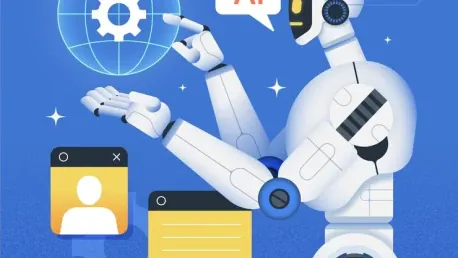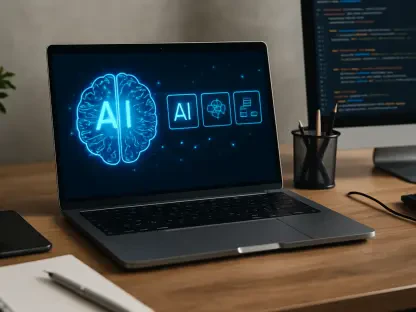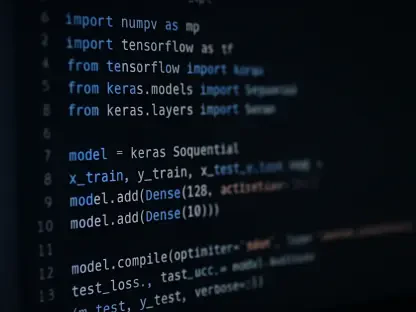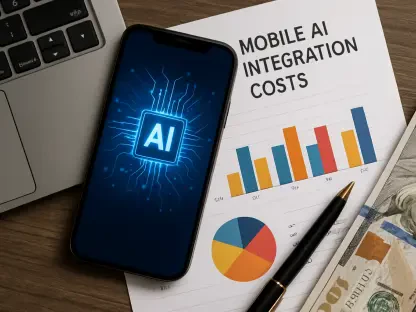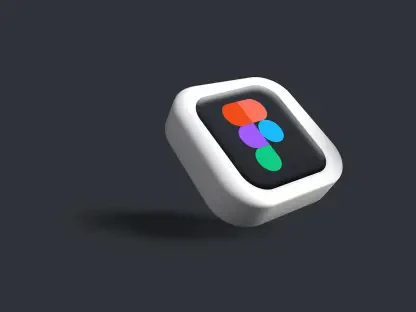In a rapidly evolving digital landscape, businesses are continuously seeking innovative solutions to enhance productivity and streamline operations. The fusion of artificial intelligence (AI) and no-code development platforms is emerging as a game-changer, enabling companies to develop sophisticated applications faster and more efficiently. This technological evolution not only accelerates development cycles but also democratizes the entire process, allowing even non-technical users to contribute significantly. Such a shift is paramount for organizations aiming to not only keep pace with rapid market changes but also to seize new opportunities as they arise, transforming how business applications are conceived and deployed.
The Power of No-Code Development
No-code development platforms have ushered in a transformative change in the software creation process, enabling users to build applications without encountering the complexities of coding. These platforms employ intuitive, visual interfaces—often featuring drag-and-drop functionality—thus making app development accessible to users with varying levels of technical proficiency. The significance of this is immense; it opens the doors of innovation wide to non-developers. Empowering non-developers means rapid prototyping and the swift deployment of applications tailored specifically to business needs can occur swiftly and effectively. The broad democratization of app development fosters a fertile ground for innovation, enabling ideas to come to life without the perpetual bottleneck that traditionally relied solely on the expertise of IT departments.
With no-code tools, companies can maintain a brisk pace in the digital race, developing solutions that precisely meet their operational requirements while cutting down on the resources typically required for traditional development. As businesses seek to innovate continuously, the ability to rapidly iterate and deploy new features becomes vital, and no-code platforms provide the backbone for this kind of agility. By tearing down the walls that previously separated business ideas from technological execution, no-code development facilitates a seamless transition from conceptualization to realization.
AI Integration Across the Software Lifecycle
Artificial intelligence further elevates the potential of no-code platforms by embedding advanced capabilities throughout the software lifecycle. From initial design stages to ongoing optimization, AI-driven features play a crucial role. They suggest relevant templates, prototype user interfaces, and refine workflows to align with key performance indicators (KPIs), ensuring efficient and effective application development. AI’s integration ensures that not only are applications built swiftly, but they are also optimized for excellence. By automating routine tasks and providing intelligent insights, AI enables business users to shift their focus toward more strategic activities.
AI tools can analyze vast amounts of data to deliver actionable insights, guiding users in designing applications that best meet their objectives. Predictive analytics can anticipate user needs and potential market fluctuations, allowing businesses to stay ahead of the curve. Furthermore, AI ensures that applications remain adaptable and responsive over time, automatically identifying and addressing inefficiencies. As a result, businesses can achieve sustained operational efficiency and maintain a competitive edge. Such seamless integration of AI and no-code development exemplifies a forward-thinking approach to digital transformation.
Spotlight on Creatio: A Leading Example
Creatio stands out as a paradigm of the harmonious fusion between AI and no-code development. The platform is specifically designed to build and automate business applications, complete with a composable architecture that allows for seamless AI integration. Even users lacking deep technical expertise can create custom workflows and customer relationship management (CRM) systems, thereby harnessing the full potential of these advanced technologies. Creatio’s array of user-friendly tools and prebuilt templates are geared toward enabling rapid and efficient app development. Business users can start with a basic prototype, enhancing and customizing it iteratively through natural language input and other detailed customizations.
This streamlined process ensures that even novice developers can build robust applications that meet intricate business requirements. The examples of functionalities already built into Creatio exemplify the capabilities of AI and no-code combined, making a compelling case for adopting such technologies across varied business sectors. By providing a more accessible and intuitive development process, Creatio breaks down traditional barriers and democratizes the creation of advanced business applications. The streamlined and efficient nature of the platform demonstrates the powerful potential of integrating AI with no-code tools.
Visual Tools for Intuitive Design
Creatio offers innovative tools like the Freedom UI Designer and Process Designer, which play critical roles in facilitating the visual design of user interfaces (UIs) and workflows. These tools allow users to model responsive UIs and structured or unstructured business processes with exceptional ease. The intuitive drag-and-drop functionality coupled with a straightforward layout helps users to visualize their applications, making necessary adjustments and enhancements with minimal effort. This visual approach dramatically reduces the complexity traditionally associated with app development, significantly lowering the barriers for non-developers.
With these tools, users can intuitively design and refine their business applications, ensuring that they meet operational goals and user requirements effectively. The drag-and-drop components simplify the building process, allowing for rapid iterations and immediate feedback, which are crucial for ensuring that applications are both functional and user-friendly. By providing these capabilities, Creatio fosters a more inclusive development environment, enabling individuals from diverse professional backgrounds to contribute to the app creation process.
AI Command Center: Enhancing Functionality
A major highlight of Creatio is its AI Command Center, a feature that empowers users to seamlessly integrate advanced AI capabilities into their applications. This includes functionalities such as predictive analytics, generative AI, and agentic features that can significantly enhance both app performance and user engagement. The AI Command Center offers extensive customization options, enabling users to tailor AI functionalities to meet their unique business objectives. This advanced feature set is a testament to how AI can be leveraged to create smarter, more dynamic applications that stand at the forefront of innovation.
By incorporating predictive analytics, businesses can proactively address potential challenges and opportunities, creating more adaptive and efficient workflows. Generative AI can automate the creation of new content and features, continuously improving the application’s value. Agentic AI capabilities can enhance user interactions, providing personalized responses and insights that boost user satisfaction and retention. The AI Command Center’s seamless integration into Creatio’s no-code platform underscores the transformative power of AI in modern business app development.
Adaptability and Flexibility in Development
No-code platforms like Creatio are renowned for their unparalleled flexibility, which allows users to define and modify processes in real-time as business needs evolve. This adaptability is crucial for businesses striving to remain competitive in a dynamic market environment. Natural language processing (NLP) capabilities simplify the creation and adjustment of workflows, allowing users to make changes using plain language commands. This further lowers the barriers to effective app development and customization, empowering users to adapt their applications swiftly to meet emerging challenges and opportunities.
The ability to make adjustments in real-time enhances the agility of the development process, ensuring that applications remain aligned with business objectives even as circumstances change. This leads to more responsive and resilient business operations, capable of navigating the complexities of a rapidly changing market. The ease with which users can implement changes also fosters a culture of continuous improvement, where applications are constantly refined and optimized based on real-time feedback and insights.
Supporting Non-Technical Users
Recognizing the challenges non-technical users might face, Creatio offers a comprehensive guide known as the No-Code Playbook. This guide is designed to navigate users through typical project phases, roles, and the collaboration tools needed to ensure successful project outcomes. The No-Code Playbook provides structured and accessible guidance, making the development process more approachable for non-developers. By offering this support system, Creatio ensures that all team members can collaborate effectively and contribute meaningfully to app creation.
The playbook’s structured approach demystifies the development process, providing clarity and confidence to those who may lack technical expertise. It covers various aspects of the development lifecycle, offering practical tips and best practices to overcome common challenges. By fostering a collaborative and inclusive environment, Creatio enables diverse teams to work together harmoniously. This empowerment of non-technical users is essential for leveraging the collective creativity and expertise within an organization.
The Future of Business App Development
In today’s fast-changing digital environment, businesses are constantly on the lookout for innovative ways to boost productivity and streamline their operations. The convergence of artificial intelligence (AI) and no-code development platforms is proving to be a revolutionary trend, enabling companies to build advanced applications more quickly and efficiently. This technological advancement not only shortens development cycles but also makes the entire process more accessible, allowing even non-technical users to make significant contributions. This shift is crucial for organizations that aim to stay competitive in rapidly evolving markets and to capitalize on emerging opportunities. It fundamentally changes how business applications are conceived, developed, and deployed, offering a new level of agility and responsiveness. Consequently, this paradigm shift is not just about keeping pace with change; it’s about transforming the way businesses operate and innovate in a dynamic digital world.
